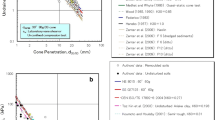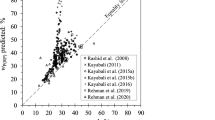Abstract
This paper presents new methods to evaluate the conditioned soil clogging potential taking into account the slump value and consistency index of the conditioned soil with pure water. In this regard, the results of some field tests performed in two metro tunnels constructed by EPB TBMs are discussed. Major geotechnical data and soil conditioning parameters discussed in this paper include Atterberg limits, natural soil consistency index, water content, liquid injection ratio (LIR), and excavated soil workability (e.g., slump test values). In this regard, using statistical analysis, two practical formulas are developed for the evaluation of the consistency index of the conditioned soil and the slump value with the coefficients of determination of 81 and 71%, respectively. A discussion is also conducted on the clogging potential evaluation, and an improved clogging potential evaluation chart is presented with slump value iso-lines. With this, it is possible to define the required water injection and slump value for the consistency index of 0.4–0.5, which refers to low clogging potential. Based on the results, the sole information of slump is not sufficient to judge the consistency index. The new charts provided in this paper help to fine-tune the slump values corresponding to the proper range of application of EPB TBMs in various plasticity index values.







Similar content being viewed by others
References
American Society for Testing and Materials (ASTM), 2003. Standard test method for slump of hydraulic-cement concrete. ASTM C143/C 143M-00
Feinendegen M, Ziegler M, Spagnoli G, Weh M (2012) Machine-driven tunneling in changeable solid rocks. softening and bonding. Mining Geo 5:784–794
Feinendegen M, Ziegler M, Spagnoli G, Weh M, Nehrer H, Fernández-Steeger TM, Stanjek H (2010) Interfacial processes between mineral and tool surfaces - bonding problem in mechanized tunneling with earth pressure shields. Geotechnic 33(2):180–184
Grandori R, Ciamei A, Busillo A, Biase AD, Perruzza P (2005) Construction of the Turin metro line 1 tunnel by 3 EPB TBMs. RETC Chapter 20:220–252
Hollmann FS (2014) Soil and rock bonds and fine grain release during mechanical tunneling. Ruhr-University Bochum, Faculty of Civil and Environmental Engineering, Ph.D. Dissertation
Hollmann FS, Thewes M (2013) Assessment method for clay clogging and disintegration of fines in mechanized tunneling. Tunn Undergr Space Technol 37:96–106
Hollmann, F.S., Thewes, M., 2011. Clogging and accumulation of fine contents in shield tunneling in soils. In. 18th Proc. Engineering Geology, Berlin, pp. 237–244.
Maidl U (1995) Expansion of the application areas of earth pressure shields by soil conditioning with foam. Ruhr-Universitat Bochum, Ph.D. Dissertation
Mori, L., Wu, Y., Cha, M., Mooney, M.A., 2015. Measuring the compressibility and shear strength of conditioned sand under pressure, Proc., Rapid Excavation and Tunneling Conf., Society for Mining, Metallurgy, and Exploration, Englewood, CO
Oliveira DGG, Thewes M, Diederichs MS, Langmaack L (2018) Consistency index and its correlation with EPB excavation of mixed clay-sand soils. Geotech Geol Eng 37(1):327–345
Peila D, Picchio A, Chieregato A (2013) Earth pressure balance tunnelling in rock masses: laboratory feasibility study of the conditioning process. Tunn Undergr Space Technol 35:55–66
Peila D, Oggeri C, Borio L (2009) Using the Slump test to assess the behavior of conditioned soil for EPB tunnelling. Environ Eng Geosci XV 3:167–174
Peila D, Oggeri C, Vinai R (2007) Screw conveyor device for laboratory tests on conditioned soil for EPB tunneling operations. J Geotech Geoenviron Eng 133:1622–1625
Peila D, Picchio A, Martinelli D, Negro ED (2015) Laboratory tests on soil conditioning of clayey soil. Acta Geotech 9:1–14
Pena M (2003) Soil conditioning for sands. Tunn Tunn Int 7:40–42
Peron JY, Marcheselli P (1994) Construction of the ‘Passante Ferroviario’ link in Milan. Italy. Lots 3P, 5P, and 6P. In: Excavation by large EPBS with chemical foam injection. Tunneling ’94. IMM, Chapman & Hall, London, United Kingdom
Quebaud S, Sibai M, Henry JP (1998) Use of chemical foam for improvements in drilling by earth pressure balanced shields in granular soils. Tunn Undergr Space Technol 13:73–180
Rivas JL, Jimenez A, Videra O, Gegout P, Vallon F, Pegon J (2009) Reducing the environmental impact of tunnel boring (OSCAR). In: Beer G (ed) Technology innovation in underground construction. Taylor and Francis, London, pp 239–259
Roby, J., Willis, D., 2014. Achieving fast EPB advance in mixed ground: a study of contributing factors, North American Tunneling, Society for Mining, Metallurgy, and Exploration, Englewood, CO., pp. 182–194
Thewes M (1999) Adhesion of clay soils during tunneling with liquid shields. In: Reports from Soil Mechanics and Foundation Engineering of the University of Wuppertal. Department of Civil EngineeringPh.D. Dissertation
Thewes M (2003) Adhesion of clay soils during tunneling with liquid shields. Geotechnic 26(4):253–261
Thewes M, Burger W (2004) Clogging risks for TBM drives in clay. Tunn Tunn Int:28–31
Thewes, M., Burger, W., 2005. Clogging of TBM drives in clay – identification and mitigation of risks. In. Proceedings ITA-AITES World Tunnel Congress, Istanbul, Turkey, pp. 737–742
Thewes M, Hollmann FS (2014) Clogging and disintegration of fines during mechanized tunneling in clayey soils. Proceedings of the World Tunnel Congress – Tunnels for a better Life. Foz Iguacu, Brazil
Vinai R, Oggeri C, Peila D (2008) Soil conditioning of sand for EPB applications. a laboratory research. Tunn Undergr Space Technol 23:308–317
Vinai, R., Peila, D., Oggeri, C., Pelizza, S., 2007. Laboratory tests for EPB tunneling soil conditioning, Proceedings of the ITA-AITES World Tunnel Congress in Prague, pp. 273 – 278
Zumsteg R (2012) Optimization of clay-polymer mixtures for soil conditioning. ETH Zürich, Ph.D. Dissertation
Author information
Authors and Affiliations
Corresponding author
Ethics declarations
Conflict of interest
The authors declare no conflict of interest.
Additional information
Responsible Editor: Hakan Tunçdemir
Rights and permissions
Springer Nature or its licensor (e.g. a society or other partner) holds exclusive rights to this article under a publishing agreement with the author(s) or other rightsholder(s); author self-archiving of the accepted manuscript version of this article is solely governed by the terms of such publishing agreement and applicable law.
About this article
Cite this article
Farrokh, E. Slump value and consistency index relationship for the application of EPB TBMs. Arab J Geosci 16, 282 (2023). https://doi.org/10.1007/s12517-023-11381-6
Received:
Accepted:
Published:
DOI: https://doi.org/10.1007/s12517-023-11381-6




